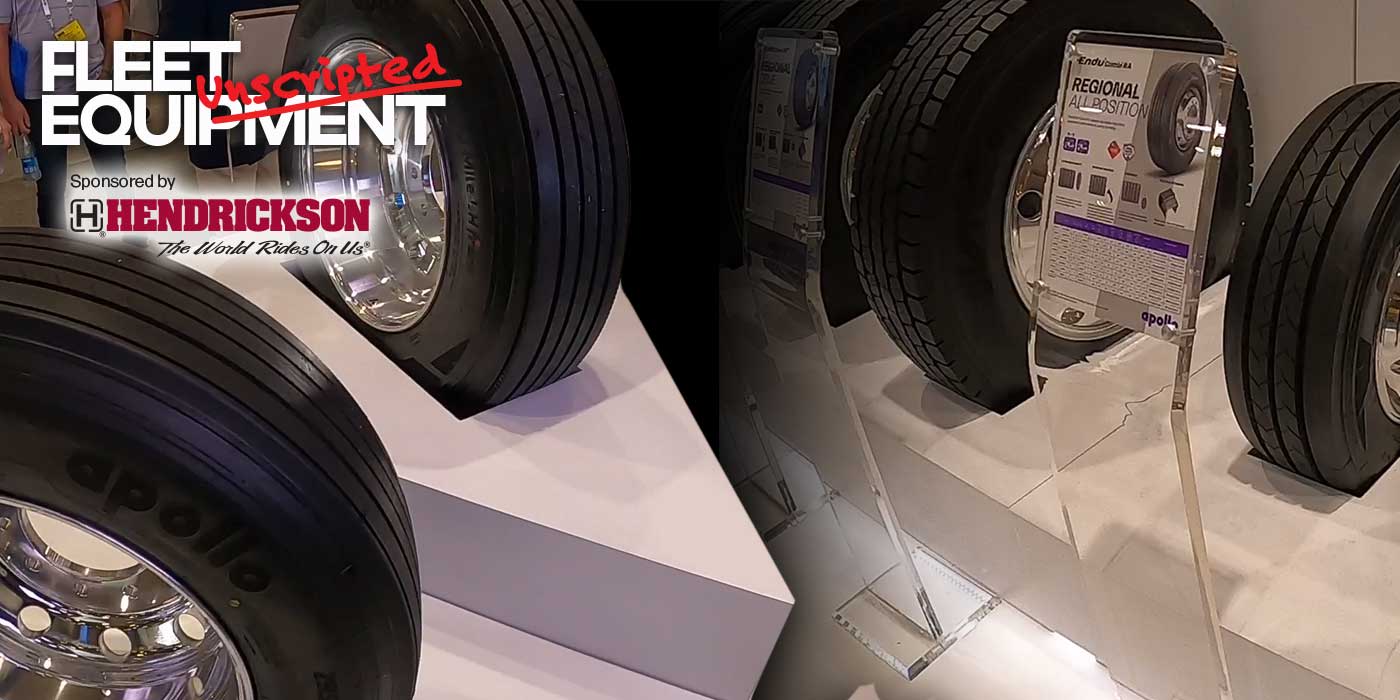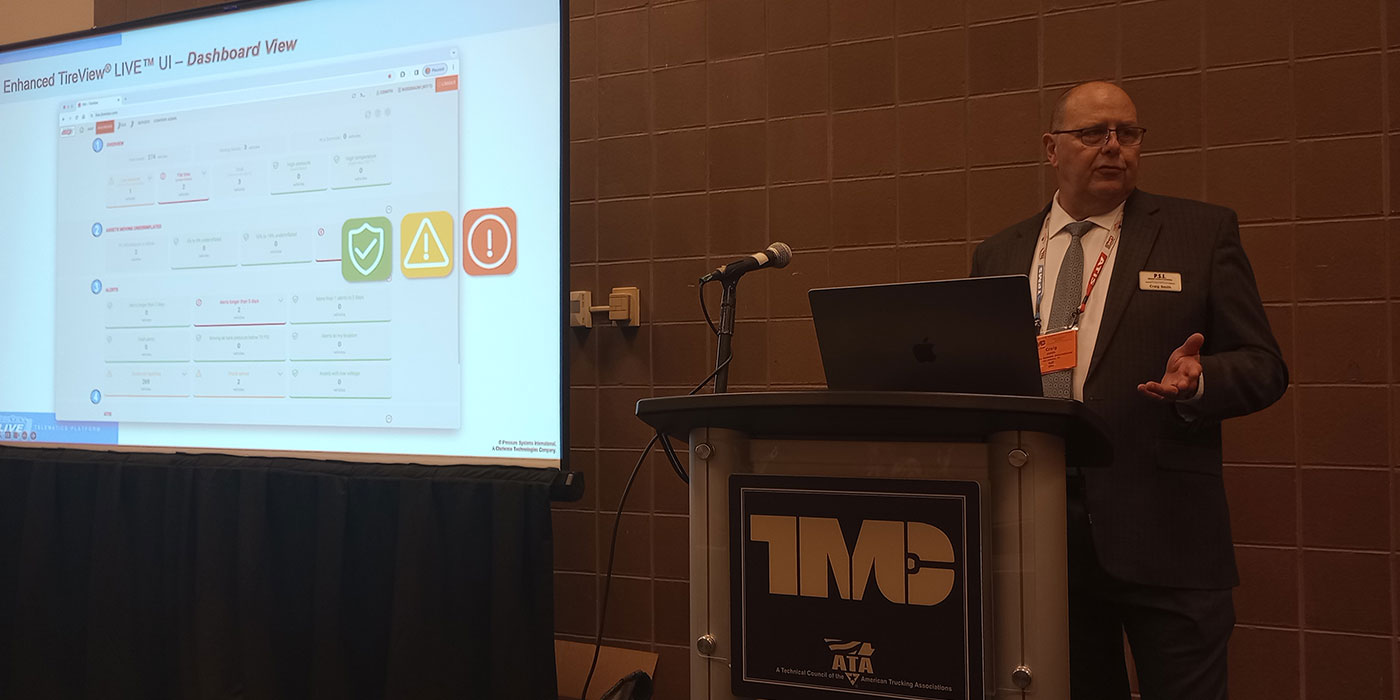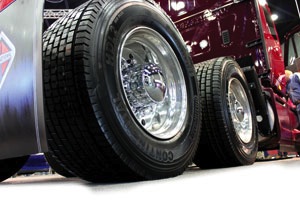 Fuel-efficient commercial tires have been available for many years. However, when fuel was selling for something in the neighborhood of a dollar per gallon, most fleet managers weren’t too interested in paying a premium for an unknown technology. As it turns out, those folks made the right decision in most cases.
Fuel-efficient commercial tires have been available for many years. However, when fuel was selling for something in the neighborhood of a dollar per gallon, most fleet managers weren’t too interested in paying a premium for an unknown technology. As it turns out, those folks made the right decision in most cases.
While there were a few products available as far back as 20 years ago that were designed from the ground up to have low rolling resistance, many others were standard tires with nothing more than a new tread compound and a shallower tread design.
That, however, is no longer the case. Guy Walenga, director of engineering for commercial products and technology at Bridgestone Americas Tire Operations, says, “When EPA first started its SmartWay program, we offered fuel-efficient tires, but we were taking normal tires and modifying them to be more fuel-efficient.
That usually meant a different tread design and a different tread compound. A lot more goes into making a fuel-efficient tire now than back then. The concept is the same, but now it’s done with a great deal more detail, and we look for every way that we can to get more fuel economy out of a tire. To do that we need to decrease the rolling resistance.”
Add life and performance to tires  According to M&R Tire Products, its Magnum Plus Tire Balancing Compound offers a great way to maximize the tread life and performance of your truck tires by keeping them balanced throughout their life at a very economical cost. Magnum Plus tire balancing compound consists of ultra-smooth microbeads that are placed in the tire during installation. As the tire rotates, the microbeads are dispersed around the tire through centrifugal force, ready to offset vibrations caused by imbalance in the tire/wheel assembly, the company notes. Operating on the principle that “every force creates an equal and opposite force,” Magnum Plus microbeads react to the outward force created by any heavy spot on the tire assembly, by moving in the opposite direction until the force is neutralized. They then remain in place while the vehicle is in motion, and re-adjust their position whenever road or vehicle conditions change, the company said. The microbeads are very durable, thereby ensuring an accurate balance throughout the life of the tire, the maker added. They can be re-used in retread tires at no extra cost to the operator. Magnum Plus microbeads are compatible with tire pressure monitoring systems, and do not require special filtered valve cores. |
Product development
Curtis Decker, product development manager for the North American region of Continental Commercial Truck Tires, offers a similar narrative. He says, “When we started developing low rolling resistance tires, we began with the tread compound because that is where we saw we would get biggest bang for the buck.
Then we moved to other parts of the tire, such as the material makeup of the body ply and the sidewall rubber construction. All of this impacts rolling resistance, although in smaller amounts than the tread compound, so we combine improvements in all of these areas to achieve the most desirable rolling resistance.”
It also is the case that the most desirable rolling resistance is not going to be the lowest possible. William Estupinan, vice president of technical service at Giti Tire (USA), says, “The goal of a tire manufacturer, when designing a low rolling resistance tire, is to achieve a balance between low rolling resistance and other performance characteristics of a tire—cornering, braking, wet and dry traction, wear rate and the absence of chipping in chunking. It took manufacturers several years to come up with formulas of silica, carbon black and filler materials that can be used to achieve a design that offers both low rolling resistance and good traction.”
Users also understand the advances made by tire manufacturers. Pat Martindale, vice president of field maintenance for Penske’s South Central Region, says, “Early on, when tire manufacturers were first introducing this technology, they were under pressure from the government, as well as users, and took advantage of the fact that as a tire wears down, it becomes more fuel-efficient. This is true for any kind of a tire, standard tires as well as fuel-efficient tires. Some manufacturers introduced fuel-efficient tires with shallower tread. The result was that you had a fuel-efficient tire, but gave up tire life.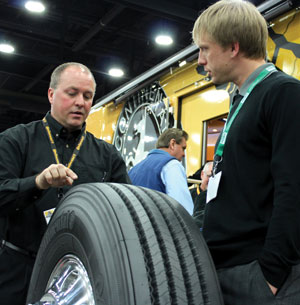
“That is not the case anymore,” Martindale adds. “Tire manufacturers have come out with much improved technology. They have changed both design and tire compound. You’re starting to see the introduction of products with deep tread life, as well as fuel efficiency built in. Such products offer the best of both worlds. The earlier disadvantages to fuel-efficient tires are being eliminated. There is also a growing inventory of tire designs that have fuel efficiency built into them.”
Tire manufacturers have made design changes in the structure of the tire itself. These new tires are the result of changes in both design and tread compound and result in lower rolling resistance. While they are not substantially different from standard tires, they do have different components and design changes. Tire manufacturers have learned a lot over the last few years as this technology has developed.
Martindale said, “I expect these designs to become the standard over the next few years. Fuel efficiency is already built into almost all the tires we use. We’re all interested in utilizing that most fuel-efficient truck possible, and tires are one of the components that can yield better fuel efficiency.”
Bridgestone’s Walenga puts it another way: “Even 10 years ago, people thought there had to be a trade-off.
To get a tire with better fuel economy, you would get less tread mileage, casing durability, poorer wet traction or retread ability—but that is no longer the case. As we develop a new low rolling resistance tire for the commercial industry, we will not offer it to the market if it trades off any of what I consider are more traditional measures of performance. We have to increase the fuel efficiency and, at the very least, keep those traditional measures where they are or, better yet, improve those traditional measures as we improve fuel economy.”
Where’s the payback?
Paul Crehan, director of product marketing for Michelin Americas Truck Tires, says, “For most fleets, fuel costs represent the single highest non-payroll operating expense. Rolling resistance accounts for approximately a third of fuel costs. The lower the rolling resistance, the less fuel consumed. A 3% reduction in rolling resistance translates into a 1% fuel savings or an increase of about .05 MPG. Low rolling resistance tires can offer both performance and fuel savings.”
Tips to identify a PreSet hub 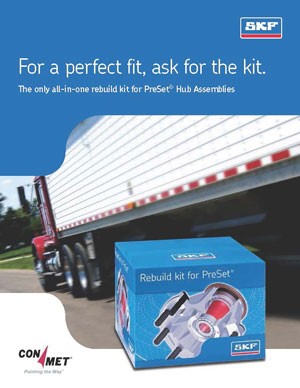 The experts at SKF have provided details on how to identify a PreSet hub assembly and ensure proper wheel end service for safe operation and optimized service life. There are three different types of wheel ends found on the road today and each of these wheel ends has specific service requirements: • Category 1: Conventional wheel assembly with seals and bearings that are manually adjusted using a dial indicator. Here are a few tips for identifying a ConMet PreSet hub assembly: PreSet hubs include assembly and/or casting part numbers. There may be other numbers surrounding these, but the part number will always start with 10 and after that there will be either 6 or 8 digits. Either part number can be entered into ConMet online hub catalog at https://vdm.conmet.com/HubCatalog and the description will be displayed. A PreSet hub assembly will always include the description that bearings are half-stand. SKF offers seals and bearings for categories 1 and 2 and a complete rebuild kit for PreSet hub assemblies (category 2), the company said. |
When the EPA launched its SmartWay Partnership, it was primarily a way to decrease exhaust emissions from commercial vehicles. The idea was simple. A truck that burns less fuel will generate less pollution. Fleets were attracted to the program because of its potential to save money and began spec’ing SmartWay-certified products to include low rolling resistance tires. As Giti Tire’s Estupinan puts it, “The SmartWay Program triggered the interest of tire manufacturers to develop products compliant with the Program’s certification criteria.”
According to SmartWay, equipping a new tractor trailer with low rolling resistance tires could cut up to five metric tons of greenhouse gas emissions per year. Of even greater interest to most fleet managers, such a move also can result in an immediate fuel savings when compared to a rig with standard tires. Recent tests of low rolling resistance tires indicate a potential fuel economy improvement of 2% to 5% compared to conventional dual tires.
Tire rolling resistance accounts for nearly 13% of the energy used by most over-the-road trucks with standard dual tire assemblies on drive and trailer axles. The use of low rolling resistance tires, either single-wide or energy-efficient dual tires, can improve that figure considerably. In particular, a wide single tire and wheel combination is lighter than two standard tires and wheels. Total weight savings for a typical combination truck using wide single tires on its drive and trailer axles ranges from 800 to 1,000 pounds.
That weight savings could either reduce the truck’s fuel consumption or increase cargo capacity for operations that are weight-limited. Single wide tires also have lower rolling resistance and aerodynamic drag than a dual configuration.
And in the city?
Can the use of low rolling resistance tires be beneficial to a city fleet? Possibly. Like so many other things, it depends on the particular operation. The optimal application for fuel-efficient tires, of course, is in long-haul operations. When we get into regional or city applications we must contend with slower speeds, tire scrubbing and tight turning applications. The fuel saving benefit offered by the use of low rolling resistance tires is highly diminished.
Continental Tire’s Decker says, “Applications in the city environment have a wide range of possibilities. No matter what, city operations are going to reduce fuel efficiency. Starts and stops, idling, aggressive acceleration and hard braking all rob energy and mitigate the advantage of going with fuel-efficient products. However, there are certainly some city operations that will benefit by using low rolling resistance tires. For example, a grocery fleet that travels into the city from a remote distribution center and then stops only three or four times before it goes back to the center might well be able to utilize the advantages offered by fuel-efficient technologies.”
Any disadvantages?
Improving the ride for better fuel economy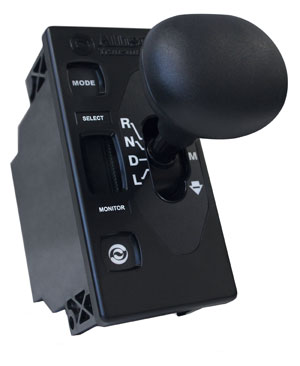 The next generation of Allison electronic controls offers a variety of features to further improve fuel economy and vehicle efficiency for the specific needs of any application. These include Load-Based Shift Scheduling, Reduced Engine Load at Stop, Shift Energy Management, Vehicle Acceleration Control and the new Enhanced Converter Load Reduction. The new Allison 5th Generation Electronic Controls feature enhanced programming and new shift selectors with greatly enhanced graphical displays that show both text and symbols, the company said. Along with the new-look Pushbutton Shift Selector, there is an all-new Bump Lever Shift Selector featuring a “bump” position that provides quick and easy selection of a specific range. Allison added its engineers also focused on upgrading the transmission control module (TCM) hardware and software for faster, more precise processing capabilities. Embedded in the 5th Generation TCM is a new inclinometer, which enhances vehicle productivity and efficiency in stop-start operations. The inclinometer’s precision and responsiveness makes Load-Based Shift Scheduling even faster and more accurate, resulting in increased reductions in fuel consumption. The new system also provides two additional acceleration levels via Vehicle Acceleration Control, which allows for an even greater ability to improve fuel economy and moderate aggressive driving practices. “The combination of Allison Transmission’s Continuous Power Technology and the latest 5th Generation electronic controls is the best way to provide our customers with enhanced fuel economy as well as improved vehicle performance, fleet productivity and efficiency,” said Steve Spurlin, executive director of application engineering and vehicle integration for Allison Transmission. |
Not everyone agrees on the subject of when not to use low rolling resistance tires. Michelin’s Crehan says, “There needs to be a consideration of the operating environment and an understanding of how the tire can contribute to the success of the fleet. A tire’s performance must sync with the nature of its operations, to its drivers and their habits, to its driving locations, to its maintenance habits, and to its budget and priorities, such as fuel costs.
“For example, if a fleet operates under winter conditions, it will be inclined to utilize a tire designed for snow traction. A refuse company will lean toward a tire designed for a hostile environment, while a logging company will seek a tire designed for on/off-road applications. Such applications will not necessarily be too concerned with rolling resistance benefits. Knowing the fleet’s application will be critical in selecting the correct tire.”
On the other hand, Brian Buckham, marketing manager at Goodyear Commercial Tire Systems, says, “There are no disadvantages to using low rolling resistance tires in city operations, or long-haul operations, for that matter.” He urges that fleets consult with their commercial truck tire dealer before choosing tires for their trucks, as they are in a position to make knowledgeable recommendations based on tire application, truck usage and other factors. Giti Tire’s Estupinan sees a growing interest in fuel-efficient tires specifically designed for short haul applications, as well as city delivery. “The need for fuel economy in city operations is certainly not as pronounced as it is for long haul fleets, but the desire for fuel economy does exist in many of these applications,” he says.
Increased tire mileage increases fuel efficiency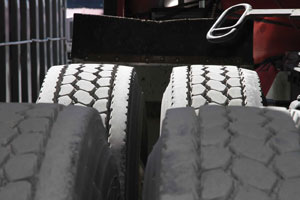 Minimizing irregular wear is the key to maximizing tire mileage, notes International Marketing Inc., maker of Equal. By maximizing even tire wear, a fleet can take advantage of the most fuel-efficient 32nds of tread. This is most evident with drive tires; due to the higher initial tread depth, drive tires have an increased opportunity for irregular wear. Minimizing irregular wear is the key to maximizing tire mileage, notes International Marketing Inc., maker of Equal. By maximizing even tire wear, a fleet can take advantage of the most fuel-efficient 32nds of tread. This is most evident with drive tires; due to the higher initial tread depth, drive tires have an increased opportunity for irregular wear.
A balanced tire resists irregular wear more than an unbalanced tire, but needs to maintain balance to achieve optimal wear and fuel economy. Internal balancing compounds, like Equal, go beyond balance to reduce causes of irregular wear at the tire and wheel assembly by continuously adapting to changes in the speed, load and road conditions. |
Everyone agrees that today’s low rolling resistance tires are not the same as those your daddy might have purchased. Will such designs become the industry standard in the future? Probably, if the price of fuel doesn’t moderate. Should they be used in city operations? Sure, if the fleet’s daily mileage makes them advantageous. You need to do some homework to figure it out if they’ll work in your operation.
Servicing pre-adjusted wheel ends: The dos and don’ts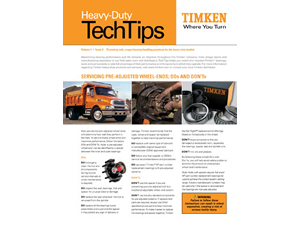 According to Timken, how you service pre-adjusted wheel-ends determines how well they perform. To service for maximum performance, follow the DOs and DON’T list below (Note: A pre-adjusted wheel-end can be identified by a spacer between the inner and outer bearings): What to do… What not to do… |


